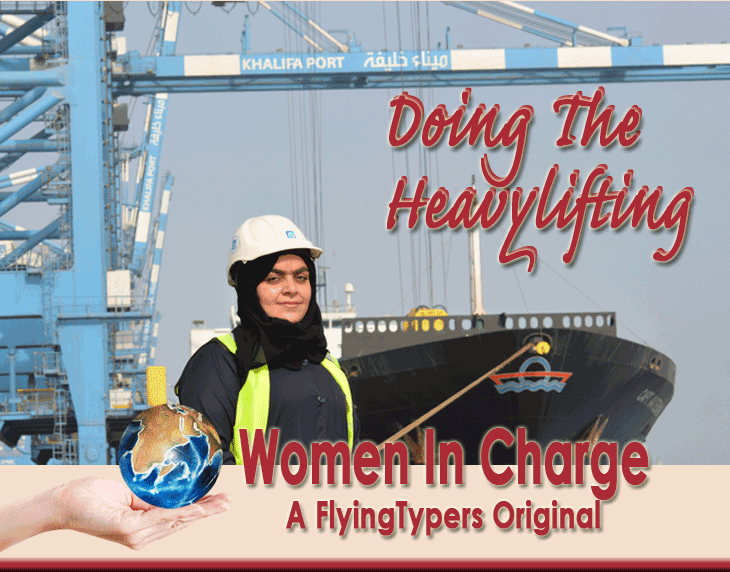
At FlyingTypers,
we’re endlessly thrilled when we hear news of women not just securing
jobs in air cargo, but also excelling in them. The news is even more exciting
when it involves a pioneering effort, which, in the case of women in air
cargo, it often does.
Last year we applauded the work of Dolores
Hofman, who currently works at the Queens Air Services Development
office, but who began as a secretary in the Pan Am Cargo office and later
became the first female to operate a commercial forklift truck in commercial
air cargo service.
This year, we travel to the UAE, where a
young woman named Ayesha Hassan AbdulRahman Al Marzooqi has been launched
on a similar career path, albeit in a much different place. Given the
special circumstances career women face throughout the world, FlyingTypers
is more than happy to shine a spotlight on the accomplishments of women
in the Middle East especially, as evidenced in our earlier 2013 article,
“Women
Power Middle East.”
Ayesha began as a clerical worker in an
office, but the 28-year-old Emirati soon set her sights on something far
more challenging and groundbreaking—Abu Dhabi Ports’ flagship
Khalifa Port. One of the most technologically advanced ports in the world,
Khalifa Port is the first semi-automated port in the GCC region and it
now boasts an even bigger claim: it holds the first female quay crane
operator in the UAE, and she also happens to be an employee of Abu Dhabi
Terminals (ADT) and the manager and operator of the Khalifa Port container
terminal.
Khalifa Port is home to a gigantic super-post-Panamax
crane, which weighs 1,932 tons and rises 126.5m into the sky. It is one
of the largest ship-to-shore quay cranes in the world, and Ayesha, currently
a trainee in the final stages of her training program, works underneath
its boom, in a small, transparent cabin where she operates the “spreader,”
a specialized tool connected to the crane’s framework. As a trainee,
Ayesha works five days a week in four-hour shifts, from 8am-4pm. She is
one of only four women in a trainee group of 23 Emiratis. From her tiny
eyrie some 60m above the ground, Ayesha manipulates steel ropes that lower
the spreader to the top of the ship to lock onto the containers. She then
maneuvers the containers dockside.
“I watched a documentary about a female
pilot in the UAE Air Force who truly inspired me,” Ayesha said.
“Before I started my training at Khalifa
Port container terminal, I was given a tour of the port facilities and
the ship-to-shore quay cranes really fascinated me. I felt this was my
calling and I decided to become a crane operator.”
Ayesha hasn’t just learned how to
handle a Panamax crane, either. She is becoming well-versed in port fundamentals,
health and safety procedures, as well as the overall infrastructure of
Khalifa Port and its present handling capacity of 2.5 million containers
a year.
“Our comprehensive on-the-job training
for Emiratis started two years ago and we are immensely proud that Ayesha
Al Marzooqi joined ADT to become the first female Emirati crane operator,”
says Senior HR Director, ADT, Eisa Hassan Al Marzooqi.
 “One
of ADT’s top strategic priorities has always been to train and develop
Emiratis to join the fast growing ports industry. As a result of this,
we have almost doubled the number of Emirati nationals within a year;
ranging from senior and middle management to supervisory and practical
roles,” adds Al Marzooqi. “One
of ADT’s top strategic priorities has always been to train and develop
Emiratis to join the fast growing ports industry. As a result of this,
we have almost doubled the number of Emirati nationals within a year;
ranging from senior and middle management to supervisory and practical
roles,” adds Al Marzooqi.
“ADT is delighted that Ayesha has
made history by becoming the first female Emirati crane operator. Being
an innovative ports operating company, we are dedicated to the development
of UAE talent and will continue to create new job openings. It is our
continued ambition that our Emirati training program grows each year along
with the significant growth of ADT,” says ADT CEO Martijn van de
Linde.
FlyingTypers believes as long as
the number of women in the Emirati workforce continues to grow, businesses
like ADT will continue to see their profits expand in kind.
Flossie Arend |





